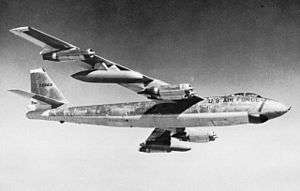429th Bombardment Squadron
| 429th Bombardment Squadron | |
|---|---|
|
2d Bombardment Wing Lockheed B-47E-50-LM Stratojet 52-3363, stationed at Hunter AFB, Georgia, about 1960 | |
| Active | 1917-1962 |
| Country |
|
| Branch |
|
| Role | Bombardment |
| Engagements |
|
| Decorations |
|
| Insignia | |
| 429th Bombardment Squadron emblem |
 |
The 429th Bombardment Squadron is an inactive United States Air Force unit. Its last assignment was with the 2d Bombardment Wing, based at Hunter Air Force Base, Georgia. It was inactivated on 1 January 1962.
During World War II, the 429th Bombardment Squadron was a B-17 Flying Fortress squadron, assigned to the 2d Bombardment Group, Fifteenth Air Force. It earned Two Distinguished Unit Citations.
History
World War I
- main: 41st Aero Squadron
Established in June 1917 as the Air Service 41st Aero Squadron at Camp Kelly, Texas as part of the United States' mobilization after its entry into World War I.After several months of routine training and garrison duties, deployed to Europe and it became operationally ready as a pursuit squadron in Second Army just as hostilities ceased in November 1918; never saw action; served with Third Army as part of occupation forces, April–May 1919. Demobilized in July.
Inter-war years
Re-established as a pilot training squadron in 1922 at Kelly Field. Taught basic flight training throughout the 1920s and early 1930s using a variety of trainers; switching to advanced flight training in 1931. In 1935 reassigned to Langley Field, Virginia and was re-equipped with Martin B-10 bombers, being re-designated as a reconnaissance squadron. Performed training flights primarily over the mid-Atlantic area; later receiving B-18 Bolos in 1937 and early-model B-17C/D Flying Fortress heavy bombers.
World War II
After the Pearl Harbor Attack, initially assigned to antisubmarine duty over the Atlantic Coast; deploying in early 1943 to Twelfth Air Force in North Africa. Engaged in long-range strategic bombing missions in the Mediterranean Theater of Operations (MTO) 1943-1945. Missions flown included bombing such targets as marshalling yards, airdromes, troop concentrations, bridges, docks, and shipping. Participated in the defeat of Axis forces in Tunisia, April–May 1943; the reduction of Pantelleria and the preparations for the invasion of Sicily, May–July 1943; and the invasion of Italy, September 1943.
Moved to Italy in December 1943 and continued operations as part of Fifteenth Air Force. Operated primarily from Amendola Air Base in Foggia. Engaged primarily in long-range bombardment of strategic targets in Germany, Poland, Czechoslovakia, Austria, Hungary, Yugoslavia, Rumania, and Greece. Participated in the drive toward Rome, January–June 1944; the invasion of Southern France, August 1944, and the campaigns against German forces in northern Italy, June 1944-May 1945. Inactivated in Italy in early 1946.
Strategic Air Command
The squadron was activated in 1958 as a result of Strategic Air Command phasing out the B-47, and additional squadrons were activated as part of the consolation of Stratojet wings, and the replacement of the B-47 by B-52 Stratofortresses. In March 1961, President John F. Kennedy directed that the phaseout of the B-47 be accelerated. and the squadron was inactivated on 1 January 1962 as part of the drawdown of the USAF B-47 force.
Lineage
- Organized as 41st Aero Squadron on 16 June 1917
- Demobilized on 2 July 1919
- Reconstituted and consolidated (1924) with 41st Squadron which was authorized on 10 June 1922.
- Organized on 7 July 1922
- Re-designated: 41st School Squadron on 25 January 1923
- Re-designated: 41st Observation Squadron (Long Range, Amphibian) on 1 March 1935
- Re-designated: 41st Reconnaissance Squadron, and inactivated, on 1 September 1936
- Re-designated: 41st Reconnaissance Squadron (Long Range) on 22 December 1939
- Activated on 1 February 1940
- Re-designated: 41st Reconnaissance Squadron (Heavy) on 20 November 1940
- Re-designated: 429th Bombardment Squadron (Heavy) on 22 April 1942
- Inactivated on 28 February 1946
- Re-designated: 429th Bombardment Squadron (Medium) on 11 August 1958
- Activated on 1 October 1958
- Discontinued, and inactivated, on 1 January 1962.[1]
Assignments
|
|
Stations
|
|
Aircraft
- SPAD S.VII, 1918
- Sopwith F-1 Camel, 1918–1919
- Included Dayton-Wright DH-4 during period 1922-1928; A-3, 1928-1935 0-19 and 0-25, 1935-1936.
- In addition to B-17 and B-18 included B-10, XB-15, and 0A-9 during period 1940-1942
- B-17 Flying Fortress, 1942–1945
- B-47 Stratojet, 1958-1961.[1]
See also
- List of American Aero Squadrons
- Boeing B-17 Flying Fortress Units of the Mediterranean Theater of Operations
References
![]() This article incorporates public domain material from the Air Force Historical Research Agency website http://www.afhra.af.mil/.
This article incorporates public domain material from the Air Force Historical Research Agency website http://www.afhra.af.mil/.
- 1 2 3 4 Maurer, Maurer (1969), Combat Squadrons of the Air Force, World War II, Air Force Historical Studies Office, Maxwell AFB, Alabama. ISBN 0-89201-097-5
- ↑ Series "E", Volume 7, History of the 28th-43d Aero Squadrons. Gorrell's History of the American Expeditionary Forces Air Service, 1917–1919, National Archives, Washington, D.C.


.svg.png)